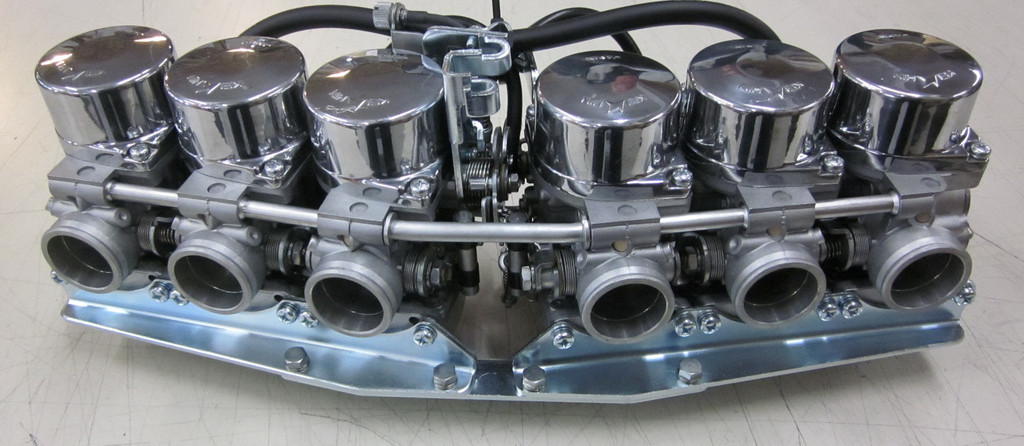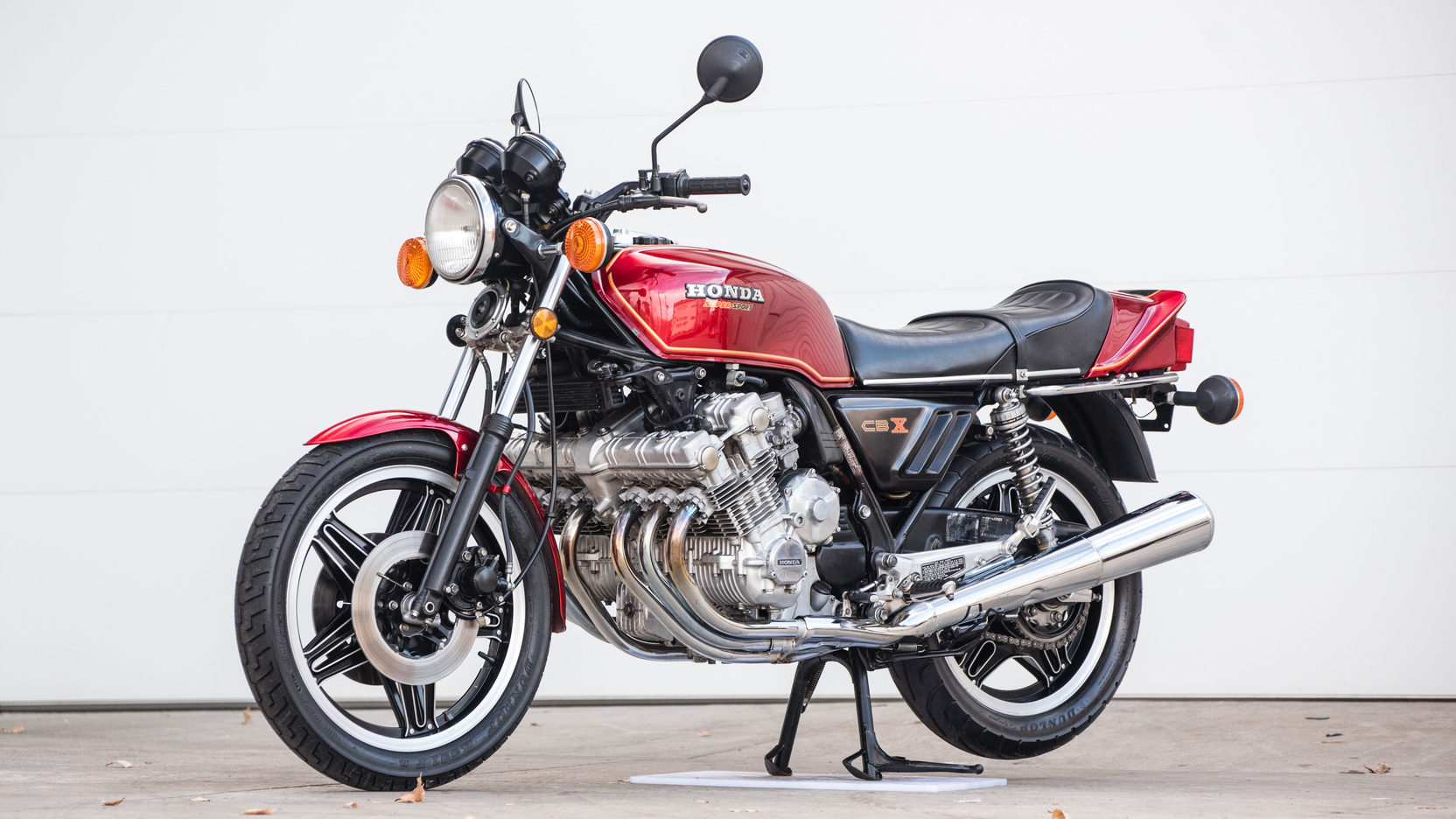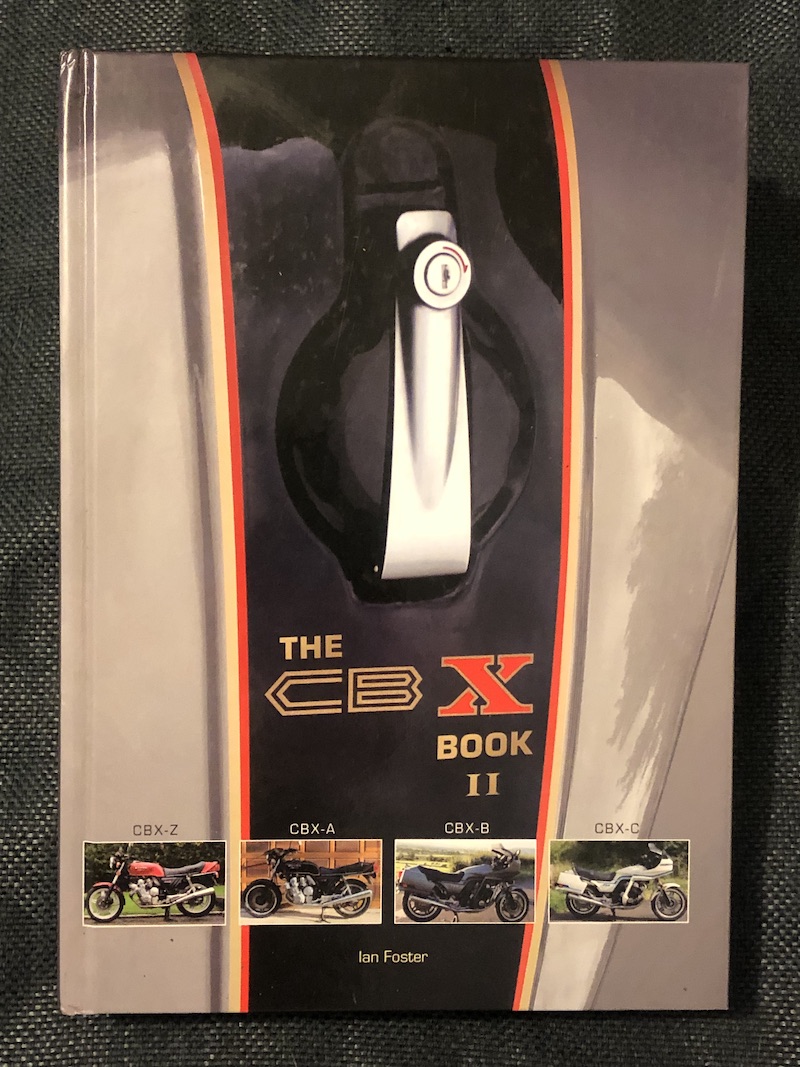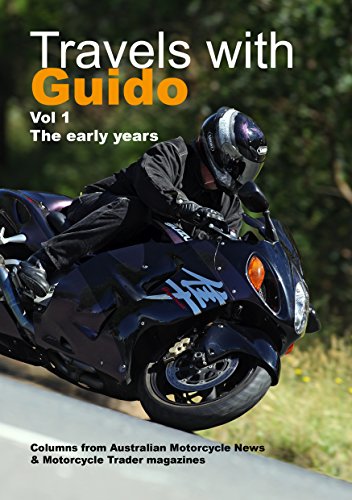Motorcycle Investor mag
Subscribe to our free email news
The mighty six
Honda CBX1000C
– our
bikes
October 11, 2025 – Guy 'Guido'
Allen
Ten months down the ownership
track, we figure it's time to share a few
thoughts on the mighty CBX
What is it about six-cylinder
motorcycles that gets under the skin? At the
moment I have two: the 2001
Honda Valkyrie Interstate, and the 1982
CBX1000C you see here. One is a flat six and the
other inline, and therefore have very different
notes – and both are fantastic to listen to.
This is my second CBX in s short space of time – the first
was nice but not really up to scratch in the
cosmetic department. This is a much neater-looking
device, once I swapped out the tired and
mismatched instruments for a new set, and ditched
the modified seat in favour of a stocker to which
I fitted a new cover.
Oh, and the final job: replacing the damaged stock
exhaust system for a new aftermarket set from Delkevic.
They fitted well and look very much like the originals,
with one exception: on the CBX1000B and C Prolink models,
there is a balance pipe between the two banks of three
cylinders. Not in this case, so it sounds much more like
the original naked versions – which I prefer. Think of it
as hearing two angry triples.

The achilles heel with these things is the complex set of
six carburettors. There is a mob in
the USA that specialises in rebuilding them, though
you can get much of the work done by any competent (and
patient!) workshop. I had the set on my previous CBX
overhauled locally at a cost of around $2000. Most (maybe
all) of that bill was labour – and it was money
well-spent.
They also have an issue with fuel leaks and you really
need to make sure you turn off the fuel tap when the bike
is not being run. Up to the B series, they had a secondary
vacuum-operated tap under the centre of the fuel tank
which had a tendency to fail, so owners bypassed it. Honda
dropped it with the C series.
I find I have to close fuel and let the bike run for 30
seconds or so, to ensure the fuel levels are down a little
before I shut down the engine. Otherwise one or more of
the carbs seem to get a weird capillary-effect happening,
where it will leak fuel even with the tap turned off!
These things are also sensitive to
fuel quality. If you have one that's not running
right, drain the fuel and replace it with a fresh
load and clean the sparkplugs. It's a laborious
task and will most likely fix the problems.
These
things can be pricey to set up and get
running properly. Aside from the
carburettors, the
workshop manual suggests
you need to tilt the
engine forward for valve
lash adjustment – a
formidable task. However
CBX1000Z owner Trevor Lock
tells us you can remove
the valve cover without
tilting the engine. He
describes it as "a bit
tricky and fiddly, but it
gets easier with
practice".
Carl
Batey over at the Cafe
Racer workshop in Wattle Flat, NSW,
adds that removing the upper engine mounts
makes the task much easier. The powerplant
is still held in place by the rear
transmission mounts. You will most likely
need to support it with a jack or similar
to get the mounting holes lined up again
as the engine may shift a little.
Once they're sorted, they are a solid-enough machine to live with so long as they are used regularly. Do the oil changes, keep it exercised, and you'll be okay.
And the final surprise? There is
an accessory setting in the ignition switch
between off and on – so you have to ensure you
switch it all the way off, or risk being greeted
with a flat battery when next you go to ride it.

This is the fourth and final model
in the CBX series, which runs CBX1000Z, CBX1000A
(above), CBX1000B and CBX1000C. The first two are
naked and the differences are largely cosmetic,
with the most obvious being a switch from gen 1 to
gen 2 Comstar wheels.
The big visual difference between
the last two was the fitment of a proper pillion
grab handle on the final model. That, by the way
is the most rare of the four, with around 2750
made.
Honda
went for slightly different tuning for
the B and C when compared to the naked series,
dialling in a fatter midrange and losing a few
horses off the top for a still-respectable 98hp
(73kW) at 9000rpm.
By far the most obvious change was
from a naked bike to a sports-tourer with Bol
d'Or-style fairing and two slim factory panniers.
Under the paint, the chassis
underwent a massive upgrade to a Prolink monoshock
rear end with adjustable rebound damping and air
preload, plus a more beefy front end, again with
air preload. One of the criticisms of the naked
versions was over their unruly handling, and these
upgrades did much to improve the situation.
However the naked versions are
more valuable.
Braking is by triple discs with
two-piston calipers and a particular point of
pride for Honda was that it managed to cast its
own ventilated rotors, the only motorcycle maker
to do so at the time.
What's it like in the saddle? The
four-valve air-cooled six likes time to warm up
before it wants to play. Once up to temp, it's
very willing to rev with a good spread of power.
Of course it sounds fantastic as it reaches the
top end and, while 98 horses might not seem a lot
these days, the performance is more than enough to
concentrate the mind. Oh, and it's very smooth.
The transmission is pretty typical Honda for the period – clunky and free of false neutrals. It has a reasonably light clutch action with a wide take-up band.
Handling is gothic by current
standards and okay for the early 1980s. It's
entirely predictable, though it's also a tall and
heavy motorcycle and definitely needs to be ridden
with an assertive attitude. Once you have its
measure, the package is a lot of fun.
Braking is only so-so – okay for
the period, with a slight delay in the 'bite', and
you need to allow it more space than a modern
machine.
Fuel consumption is on the heavy
side, with 15km/lt (42mpg UK, 35mpg US)
possible at a 100km/h (60mph) cruise, dropping to
more like 10km/lt (28mpg UK, 23mpg US) and lower
if you're able to cut it loose.
This
bike, with the lairy paint scheme (who
knew white could be lairy?!), draws a lot
of attention – particularly from younger
folk, by which I mean men in their 20s and
30s. Sadly, no young women have engaged
with it. So far...
It's comfortable, with the fairing
offering good protection from the ankles up to
about neck level. That said, I have far more
capable tourers in the shed, and this really is
kept as a bit of a treat to ride on a sunny day.
In that role, it's fantastic.
Specifications
Honda 1982 CBX1000C
Good
Fast
Huge presence
Loads of engine character
Not so good
Big
Heavy
SPECS:
ENGINE:
TYPE: air-cooled, four-valves-per-cylinder, inline six
CAPACITY: 1047cc
BORE & STROKE: 64.5 x 53.4mm
COMPRESSION RATIO: 9.3:1
FUEL SYSTEM: 6 x 28mm Keihin carburetors
TRANSMISSION:
TYPE: five-speed, constant-mesh,
FINAL DRIVE: chain
CHASSIS & RUNNING
GEAR:
FRAME TYPE: steel tube, diamond pattern main section, with
engine as stressed member
FRONT SUSPENSION: telescopic fork, air preload adjustment
REAR SUSPENSION: Prolink monoshock, air preload and 3-way
rebound damping adjustment
FRONT BRAKE: 2 x 276mm ventilated discs with 2-piston
calipers
REAR BRAKE: 276mm ventilated disc with two-piston caliper
DIMENSIONS &
CAPACITIES:
WET/DRY WEIGHT: 277/308kg
SEAT HEIGHT: 810mm
WHEELBASE: 1535mm
FUEL CAPACITY: 22lt
TYRES:
FRONT: 100/90-19
REAR: 130/90-18
PERFORMANCE:
POWER: 98hp (73kW) @ 9000rpm
TORQUE: 84Nm @ 7500rpm
OTHER STUFF:
NEW PRICE: Au$4950 + ORC in 1982 (US$3250, GB£2450, €2800)
VALUE of a good example in 2025: circa Au$20,000
(US$13,100, GB£10,000, €11,300)
The CBX book

Author Ian Foster
produced a legendary and huge hardbound book on the
CBX1000 series, which was published as two editions – 2011
and 2014. The second is shown here. It's a must-have for
an owner, though supplies are scarce and you can expect to
pay several hundred dollars for a copy.
Know your CBX
There are four variants –
two naked:
CBX1000Z – approx 25,000 made
CBX1000A – approx 5000 made (easy ID: second-gen 10-spoke
Comstar wheels)
And two with fairing and
Prolink rear end:
CBX1000-B – approx 3750 made
CBX1000-C – approx 2750
made (easy ID: it has a solid pillion grab rail at the
rear of the seat)
See
the period road test of the CBX1000Z in Classic
Two Wheels
Leno's CBX
Comedian and collector Jay Leno owns a
1981 CBX1000B –the first new vehicle he ever bought. See the video
here.
***
-------------------------------------------------
Produced by AllMoto abn 61 400 694 722
Privacy: we do not collect cookies or any other data.

Archives
Contact




